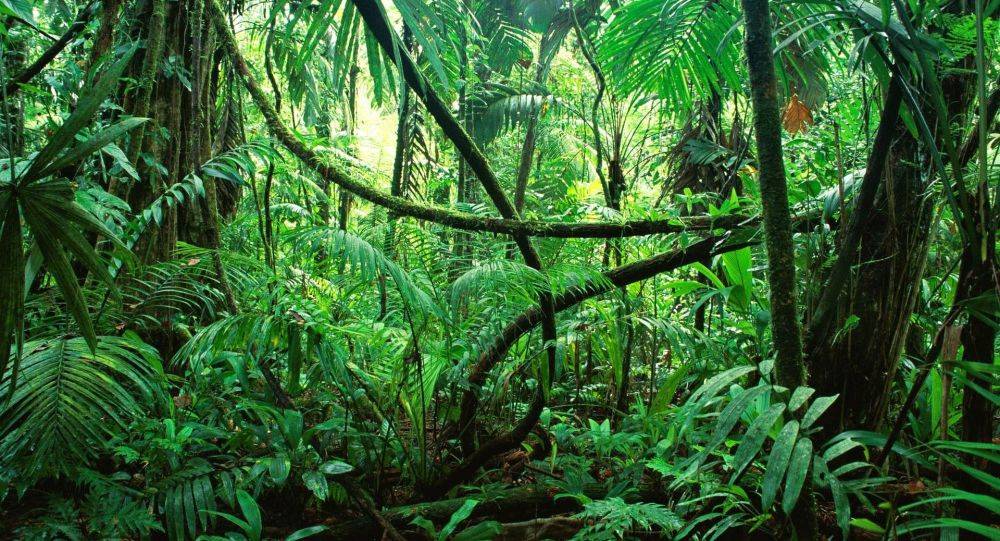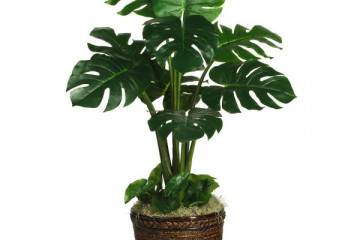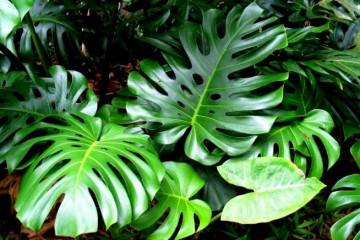Where does monstera grow in nature - the birthplace of the plant
Content:
Monstera is a plant of the Aroid family of the monocotyledonous class. In total, more than 20 species of bizarre liana are known. Appearing in the tropics, it spread throughout the world. Some species are adapted for growing in greenhouses and houses. Monstera looks spectacular in large rooms, when it is possible to put down many aerial roots and grow, clinging to supports. The popularity of the flower is given by legends and omens that endow it with monstrous properties.
How to recognize a monster
The evergreen is famous for the legends that call it a killer. It is believed that it can harm a person, up to and including death.
What kind of plant is this monstera
Monstera is a tropical vine. But she does not have a whimsical character, so you can find her in apartments and offices. Sometimes a monster is called a palm tree. At the same time, attention is paid to its leaves and the method of attachment to neighboring plants. Some types of palms have creeping and climbing shoots.
So what is a monstera - a plant that brings bad luck and an energetic vampire or a beautiful vine, endowed with dangerous properties out of ignorance?
In the jungle, the remains of people were found, the skeletons of which were braided and pierced with the branches of a flower. There is an explanation for this. From the description of the monstera, it is known that the plant is capable of forming aerial roots. They make the vine independent of the ground, although they constantly continue to reach for it. It was the roots that frightened people, casting shadows and taking on bizarre outlines. Frightened travelers thought they saw the tentacles of a terrible monster. Lost travelers have been lost in the thickets of the jungle. They died of hunger, thirst, or the paws of wild animals and got stuck in the branches of numerous plants. And the roots of the monstera later grew through their bones. People saw only the dead, entwined with a monstrous, in their opinion, liana.
Botanical description
Monstera is constantly changing with age. This applies not only to its size, but also to the cut leaves. Namely, they are one of the main features of a tropical flower.
What does a monstera look like:
- the leaves are large carved, in shape they resemble burdocks. Their diameter reaches 85 cm. When they first appear, they are rolled up and have no slits. They form with age. At first they look like slightly perforated, by the end of life they become completely cut;
- the root system is well developed. A plant cannot exist without support. Releases aerial roots that help to cling to everything that surrounds it. They reach for the ground, trying to get nutrients. If it is not possible to take root, this does not affect the growth and health of the flower. Aerial roots are the most delicate part of the plant, even though they are firm and tough. It is they who instantly react to climate change, lack or excess of moisture;
- stems are dense and long, climbing;
- flowers are collected on the cob, having the shape of a cylinder. Later, an edible fruit is formed in their place. It has a juicy, yellowish pulp. The main thing is to eat it when the fruit is ripe.
In its natural habitat, the monstera grows rather quickly and climbs other trees to a height of 12 m. Living indoors, the liana is not able to reach such sizes. Usually it grows up to 1 m with support, the maximum stretches with proper support up to 5 m.
Breeders have bred many varieties and types of plants, for example:
- monstera Adanson, on the leaves of which there are many holes scattered in random order;
- monstera marble has a green-beige color. It extends not only to the leaves, but also to the stems;
- monstera punched. Its leaf plates are perforated in different places. The holes are oblong, their length is constantly changing.
Where does monstera grow
Monstera, home to Central America, is widespread throughout the world. Already in the 19th century. she got to Southeast Asia, quickly and successfully took root in new territories.
Habitat in nature
The plant prefers tropical and mountain forests, it can rise a kilometer above sea level.
Where does monstera grow:
- on the territory of Brazil;
- in Mexico;
- on the Yucatan Peninsula, which is located between the Gulf of Mexico and the Caribbean Sea.
Over time, the tropical vine began to move around the world and took root in areas with a temperate climate.
Home to the monstera plant, South America provides ideal conditions for many flowers, trees and grasses. Tropical rainforests are home to more than half of the world's flora from around the world.
Behavior in the wild
Monstera survives thanks to other representatives of the flora. But she is not a parasite, does not consume the nutrients of other jungle inhabitants, but simply uses them as support. Such plants are called epiphytes. They can grow independently of the soil and live comfortably among dense thickets. Aerial roots give them the ability to move closer to sunlight.
In nature, monstera can reach a length of 250 m.The plant lives for about 30 years, but at home the duration is sharply reduced. Many representatives are withering away already in the fifth year. Even the necessary care, high humidity and an abundance of sunlight do not prolong the life of an unpretentious plant.
The berries, which are the fruits of the plant, are used for food. They are specially grown and served as a delicacy. They taste like pineapple, which even outwardly resembles the pulp of the fruit.
When monstera blooms
The inflorescence appears in early spring. The fruit is formed within 10 months. On the mainland, where the monstera grows, whatever the weather conditions, flowers are tied every year. At first, the petals are tightly compressed like tulips, and then open like a sail. It is sometimes compared to a blanket that wraps around a cob. It is located in the center of each flower, similar to corn, but only light. It can be pure white, boiling white or pale gray. Then a fruit is formed in place of the flower. It is the same size as the cob.
When studying the composition of the fruits of the gourmet monstera, the following substances and elements were found:
- vitamin C;
- phosphorus;
- calcium;
- thiamine.
They also contain proteins, fats and carbohydrates.
Why is the monstera "crying"
Sometimes drops appear on the leaves of monstera, resembling dew or tears.
There are several versions of why the monstera is crying:
- due to high humidity, for example, in cloudy weather, during prolonged rains. Aerial roots absorb moisture in large quantities, and do not have time to evaporate it naturally, so it forms on the leaves. There is nothing mystical and scary in this, just the plant removes excess liquid. And humid air does not allow evaporation from the leaves. As soon as the weather returns to normal, the pressure takes on normal values, the process stops;
- sometimes the monstera "cries" when, on the contrary, she does not have enough fluid. But in the tropical rainforests of South America, rainfall is abundant and uniform throughout the year. Therefore, a similar problem arises rather when growing monstera at home. The plant is believed to be able to predict weather changes. When drops appear on its leaves, it means that it will soon rain, thunder.
The unusual liana is surrounded by a mass of rumors and legends. It is believed that where the monstera lives, you need to wait for trouble. She is able to take away all the joy and positive emotions, returning sadness and negativity. This is partly why many do not seek to grow a houseplant or want to get rid of an existing one. But all the dangerous properties of the plant associated with the influence on the energy and climate in the family are just fictions. They are not supported by scientifically proven facts.




















